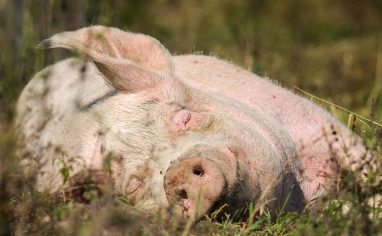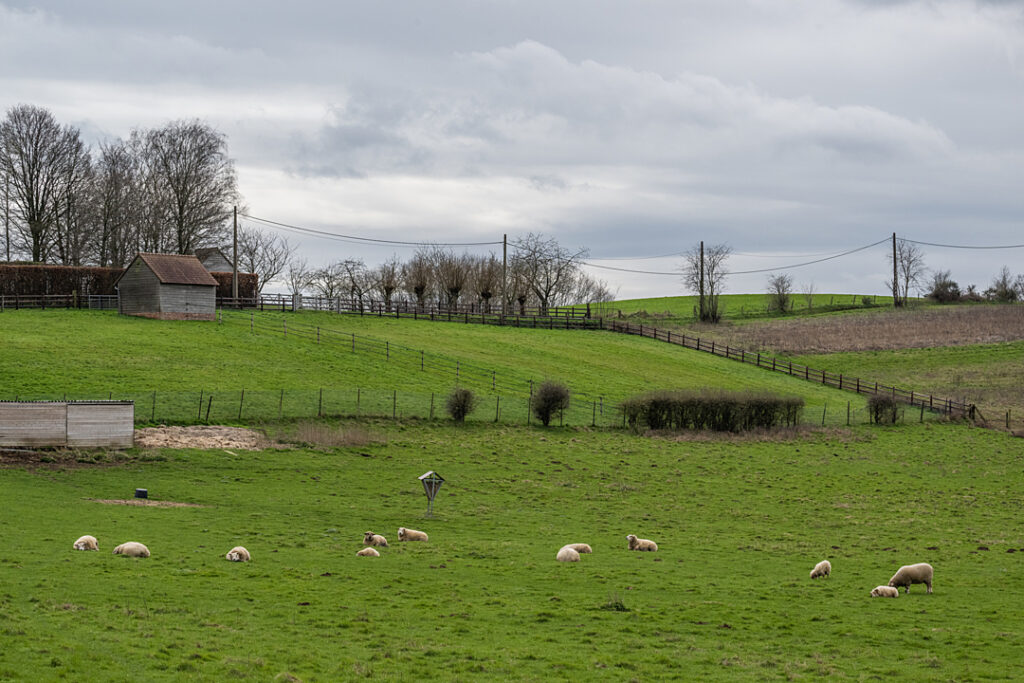
Important Concepts To Know Before Reading This Resource
The following is an excerpt from the Gentle Handling And Restraint section of Basic Sheep And Goat Care Part 2, one of the free course offerings available at our Compassionate Care Classroom. If you are not already familiar with the concepts of flight zone, pressure zone, and point of balance, please check out this excerpt from the course before moving on to this one. These concepts are mentioned but not explained in the following excerpt and play an essential role in learning how to herd residents. For a more thorough understanding of this topic, we highly recommend checking out our Basic Sheep And Goat Care course!
Earlier, we mentioned that you may need to calmly encourage the entire group to move to a more enclosed space before attempting to restrain anyone. While we recommend being strategic about the scheduling of care tasks (taking your residents’ daily routine into consideration), there will inevitably be things that come up that require you to approach and restrain a resident during times when they are not in a space that is conducive to getting close to them. Therefore, it’s important to learn how to calmly herd sheep and goats. Remember, because small ruminants are flock/herd animals, it is almost always easier to encourage the entire group to move rather than trying to move a single individual. This is particularly true with sheep – attempting to move one individual or even a small group could cause them to panic and try to rejoin the group. With goats, you may be able to get away with moving a small group of bonded individuals versus the entire group, but this all depends on the makeup of the herd.
While herding can play an important role in preparing to approach and restrain someone, that certainly isn’t the only time this skill might come in handy. Through time and patience, you may be able to teach your sheep and goat residents to come when called (especially if you mostly call your residents for positive things, such as announcing that you are giving them access to a different outdoor space that is brimming with fresh forages), but even if your residents typically come when called, it’s still important to know how to gently herd a group of sheep or goats. There may be a time when residents are reluctant to move to a certain area on their own, or you may need to herd a group of new rescues who aren’t familiar with you yet. If your sanctuary does rescue, you may need to use your herding skills to facilitate the rescue of certain individuals. Knowing how to calmly and efficiently herd your residents can also play a very important role during emergency situations, especially if an evacuation is necessary.
What About Herding Dogs?
As mentioned in Part One, we don’t recommend housing dogs with sheep or goats due to safety concerns and the fact that a dog’s presence may cause a sheep or goat distress. For these same reasons, we do not recommend the practice of using dogs to herd sheep and goats. Not only could this put your residents at risk of injury if the dog were to attack them, but it could make the herding process unnecessarily stressful for them.
To herd small ruminants, it can be helpful to have at least one helper. While it certainly is possible to encourage a group of residents to move without help, having another human involved can make things easier. This is especially true if the group is large, the space they are in is vast, or if one or more residents are fearful (when working with individuals who don’t yet know you or are in a stressful situation, it’s a good idea to have multiple people on hand to help).
To start, you need all humans involved to position themselves behind the group. Remember what we talked about earlier – sheep and goats are unlikely to continue moving forward if a human is in front of them. Therefore, it’s important to make sure that all folks in the space know to stay behind the residents. Even if a human is on the other side of a barrier, if they are in the sheep and goats’ line of sight and are in front of them, the residents will likely change course. If positioning yourself behind the group requires that you walk past residents, avoid walking through the group or getting too close to residents (and entering their flight zone), as this may cause them to move further away. Instead, move along the periphery, giving residents a wide breadth and watching their body language. Walking through the group or walking too close to residents could cause them to turn and move away from you.
Once positioned behind the group, you can calmly and intentionally start moving forward, slowly entering the flight zone of the individuals at the back of the group, but being careful not to get too close to residents or to cross anyone’s point of balance. Using verbal cues can also be helpful, perhaps saying in a pleasant tone, “Go on,” or “Time to go inside,” or whatever else feels appropriate to the situation. Through consistency, you may find that positioning yourself behind them and saying a verbal cue they are familiar with will encourage them to move without any further encouragement needed on your part. In situations where residents are less accustomed to being moved or are showing signs of stress, it’s helpful to closely observe everyone, watching for signs someone seems ready to flee. By anticipating this, you can reposition yourself to encourage them to continue to move in the desired direction. If tensions are high and residents seem stressed, it’s best to either back off (if the task at hand allows for it) or enlist the help of other caregivers. The more humans you can get to form a gently curved line behind the residents (taking care not to get in their blind spot or cross their point of balance), the more likely you’ll be able to gently encourage a reluctant group to move.
Let’s look at an example to better understand how to calmly herd residents. In the graphic below, imagine caregivers needing to calmly herd the group of sheep (which could also be goats) from where they are through the gate at the bottom corner of the pasture. Let’s also imagine that the only way for caregivers to move into this space is through that same gate.
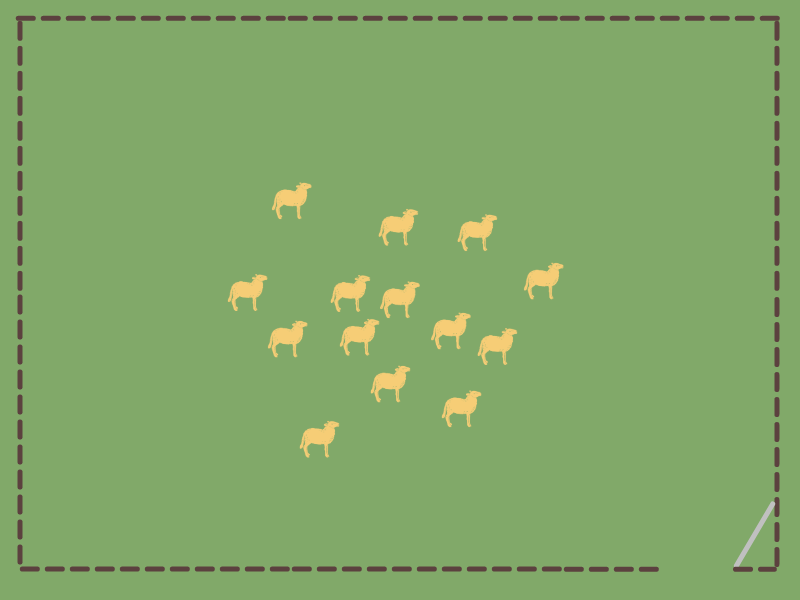
To get from the gate to their position behind the group (indicated by blue markers), they’ll want to walk around rather than through the residents.
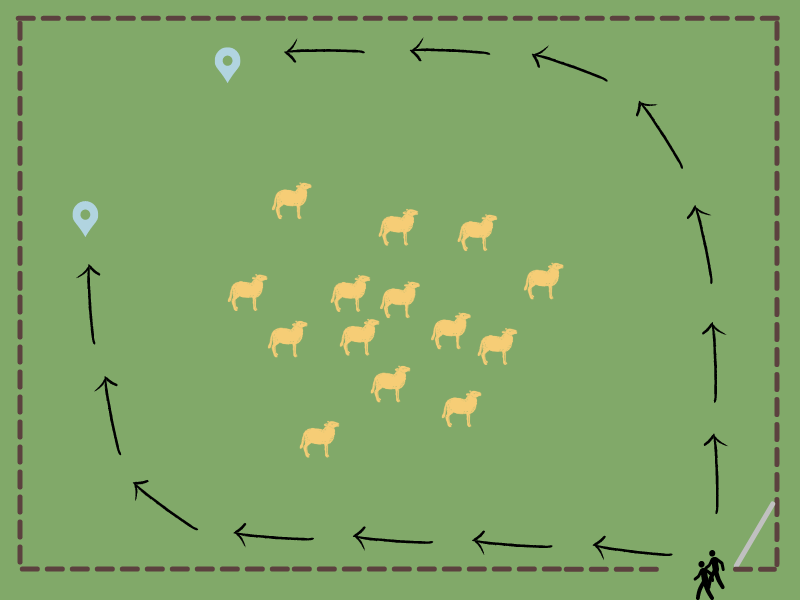
If the caregivers instead walked through the group or got too close to the group, the residents would likely turn around and move away from the caregivers. Not only might this cause some of the residents to panic, increasing the size of their flight zone, but it will also result in the residents moving away from, rather than toward, the gate caregivers need to herd them through.
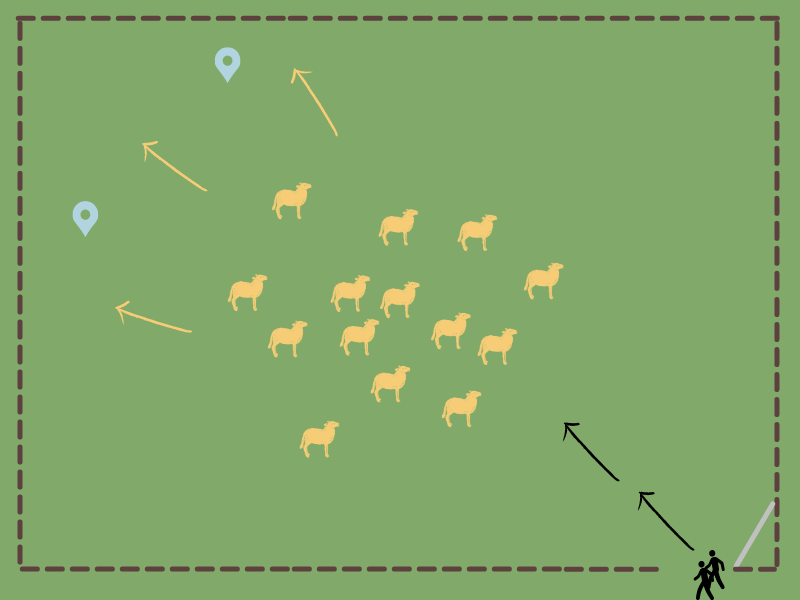
Once the caregivers are positioned behind the group, they can calmly start moving forward, being careful not to get too close to anyone. The goal is to get close enough to encourage them to move away from you, but not so close that they panic and flee, and you definitely don’t want to cross anyone’s point of balance.
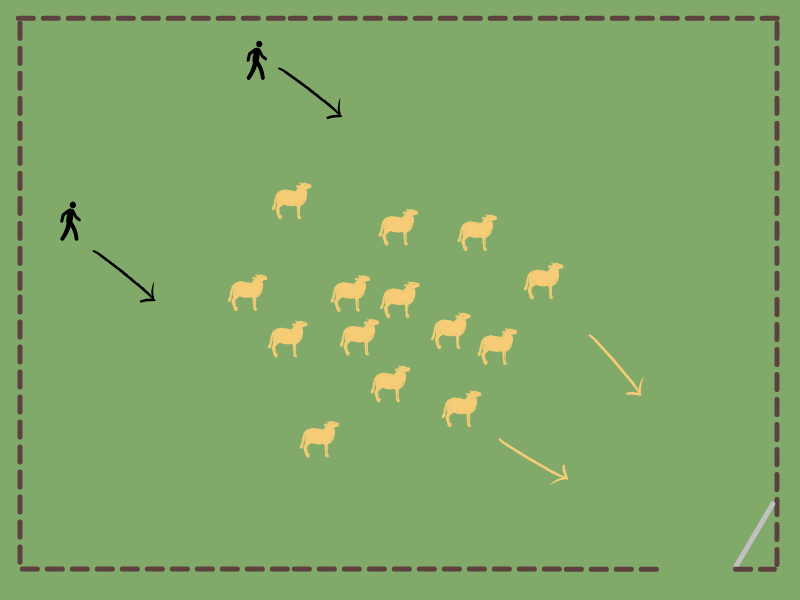
Want To Learn More?
For a more comprehensive look at handling, restraining, and working with sheep and goats, in addition to other essential care topics, be sure to check out Basic Sheep And Goat Care!






